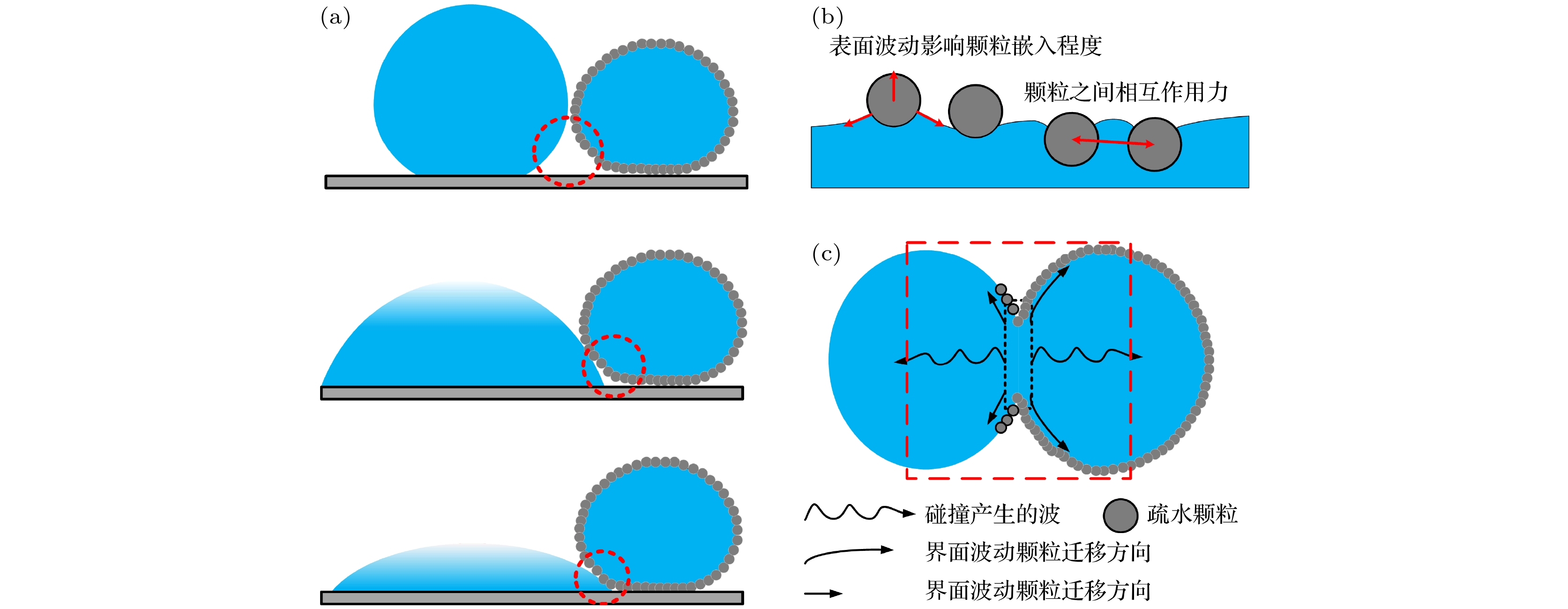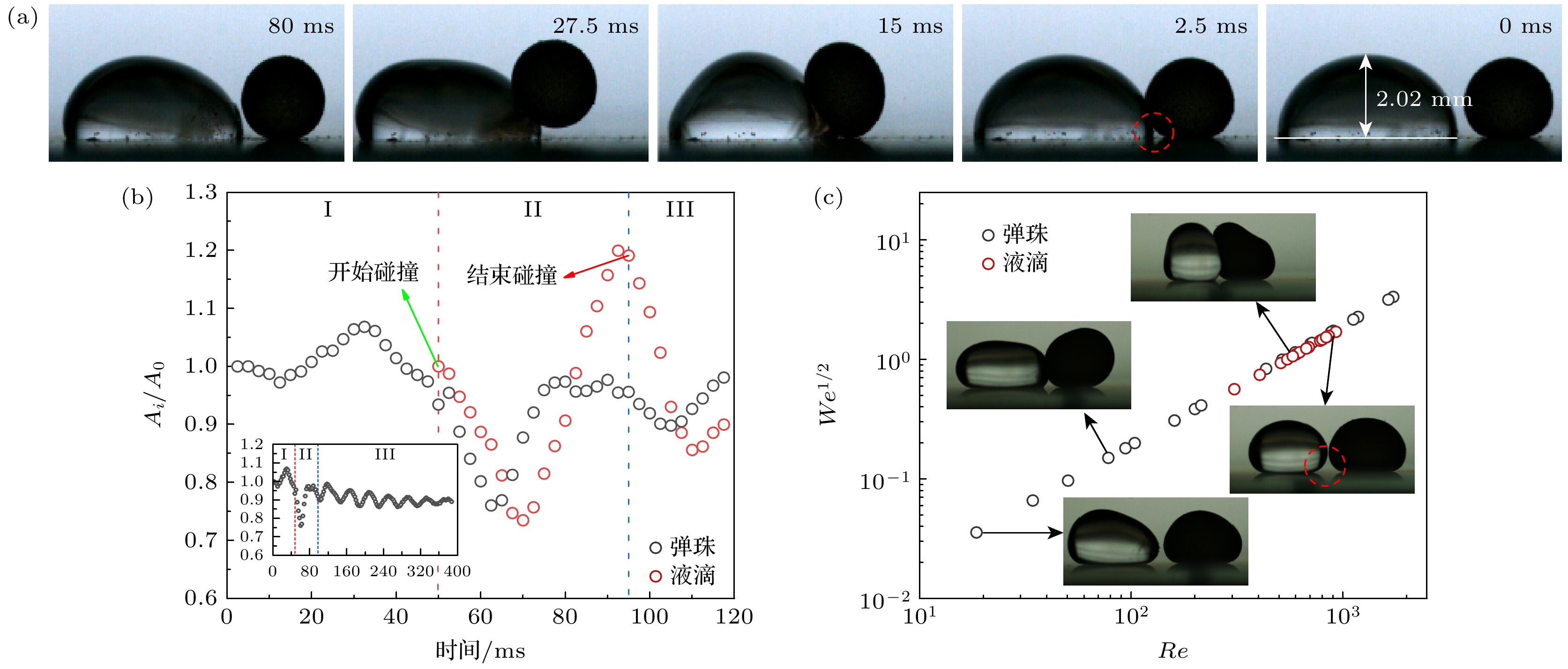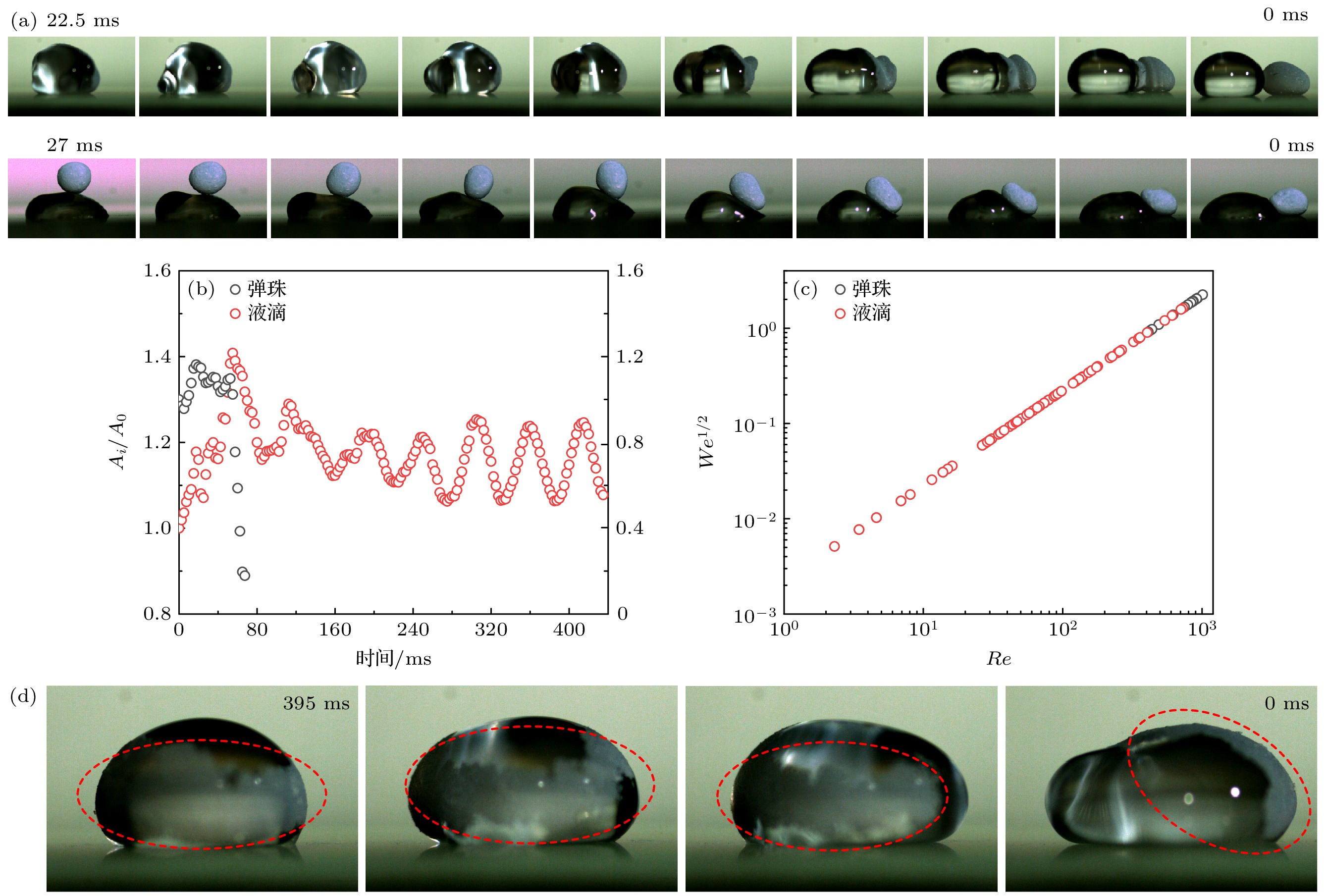-
液体弹珠具有不润湿/不黏附, 以及与外界进行选择性物质交换等特性, 可以作为微量液滴承载体, 广泛运用于微流控、化学/生物微反应器等新兴领域. 碰撞可作为弹珠进行物质传递的一种操控方法, 区别于液滴-液滴或弹珠-弹珠的碰撞, 弹珠与液滴的碰撞行为更为丰富与复杂, 对其的研究可为以弹珠为媒介的物质的有效传递奠定理论基础. 本文利用高速摄像机拍摄技术, 捕捉了液体弹珠与固着液滴碰撞过程, 探究了不同奥内佐格数(Oh)以及壁面亲/疏水性(接触角: θ 为35.4°—124.5°)下弹珠与液滴之间的碰撞过程. 结果表明: 在亲水壁面时, 以翻越的形式与液滴结束碰撞; 当改用疏水壁面后, 以回弹行为取代翻越; 当壁面疏水性提高接触角达到θ = 124.5°时, 有效碰撞面积增大, 碰撞后在界面产生的波动使弹珠表面的颗粒迁移, 出现裸露区域, 形成液桥后快速完成聚结-合并(聚并). 弹珠与固着液滴碰撞后, 会出现三种运动行为即翻越、回弹以及聚并.Liquid marbles can be used as micro-droplet carriers due to their non-wetting, non-adhesion, and selective material exchange with the outside environment, wide applications in emerging fields like microfluidics and chemical, biological, and chemical microreactors. The collision can be used as a method of manipulating material transfer by marbles, which has significance and research value. Unlike droplet-droplet or marble-marble collisions, the collision behavior between marbles and droplets is more abundant and complex. The study of this process is vital for effectively transferring the material with marble as the medium. In this paper, high-speed camera filming technology is used to capture the collision process between liquid marbles and sessile droplets. The collision process between marbles and droplets is investigated for different Ohnesorge numbers (
$Oh$ ) and wall hydrophilicity/hydrophobicity (contact angle:$\theta \sim 35.4^\circ \text{–}124.5^\circ$ ). This research demonstrates that at the hydrophilic interface, the contact angle formed between the droplet and the interface is small (θ ≤ 61.3°), and when the collision occurs, the effective contact area is small, which cannot form a larger obstruction to the forward motion of the marble and ends the collision with the droplet in the form of overturning; when the hydrophobic interface is changed into the hydrophobic interface, the effective collision area increases, which forms a larger obstruction to the forward motion of the marble and replaces overturning with rebound behavior; when the hydrophobicity of the interface increases to θ = 124.5°, the effective collision area becomes larger, and the fluctuations generated at the interface after the collision cause the particles on the surface of the marble to migrate and appear in the exposed area, forming a liquid bridge and then quickly completing the aggregation. When marbles and sessile droplets collide, three distinct motion behaviors emerge: climbing, rebound, and coalescence-merging (coalescence).-
Keywords:
- collision /
- liquid marble /
- sessile droplet /
- hydrophilicity/hydrophobicity
[1] Kim J 2007 Int. J. Heat Fluid Flow 28 753
 Google Scholar
Google Scholar
[2] Kim S Y, Choi B G, Baek W K, Park S H, Park S W, Shin J w, Kang I H 2019 Smart Mater. Struct. 28 035025
 Google Scholar
Google Scholar
[3] Watson G S, Green D W, Schwarzkopf L, Li X, Cribb B W, Myhra S, Watson J A 2015 Acta Biomater. 21 109
 Google Scholar
Google Scholar
[4] Kelleher S M, Habimana O, Lawler J E, O’ Reilly B, Daniels S, Casey E, Cowley A 2016 ACS Appl. Mater. Interfaces 8 14966
 Google Scholar
Google Scholar
[5] Park K C, Chhatre S S, Srinivasan S, Cohen R E, McKinley G H 2013 Langmuir. 29 13269
 Google Scholar
Google Scholar
[6] Chen H, Li A, Zhang Y, Zhang X, Zang D 2022 Phys. Fluids. 34 092108
 Google Scholar
Google Scholar
[7] 罗新杰, 张熙, 冯玉军 2020 物理化学学报 36 1910007
 Google Scholar
Google Scholar
Luo X J, Zhang X, Feng Y J 2020 Acta Phys. Chim. Sin. 36 1910007
 Google Scholar
Google Scholar
[8] Aussillous P, Quéré D 2001 Nature 411 924
 Google Scholar
Google Scholar
[9] Thomson J J, Newall H F 1886 Proceedings of the Royal Society of London 39 417
 Google Scholar
Google Scholar
[10] Worthington A M 1877 Proceedings of the Royal Society of London 25 261
 Google Scholar
Google Scholar
[11] Worthington A M 1883 Proceedings of the Royal Society of London 34 217
 Google Scholar
Google Scholar
[12] Menchaca-rocha A, Martínez-Dávalos A, Nuñez R, Popinet S, Zaleski S 2001 Phys. Rev. E 63 046309
 Google Scholar
Google Scholar
[13] Aarts D G, Lekkerkerker H N, Guo H, Wegdam G H, Bonn D 2005 Phys. Rev. Lett. 95 164503
 Google Scholar
Google Scholar
[14] 毕菲菲, 郭亚丽, 沈胜强, 陈觉先, 李熠桥 2012 物理学报 61 184702
 Google Scholar
Google Scholar
Bi F F, Guo Y L, Shen S Q, Chen J X, Li Y Q 2012 Acta Phys. Sin. 61 184702
 Google Scholar
Google Scholar
[15] 王凯宇, 庞祥龙, 李晓光 2021 物理学报 70 076801
 Google Scholar
Google Scholar
Wang K Y, Pang X L, Li X G 2021 Acta Phys. Sin. 70 076801
 Google Scholar
Google Scholar
[16] 梁刚涛, 郭亚丽, 沈胜强 2013 物理学报 62 184703
 Google Scholar
Google Scholar
Liang G T, Guo Y L, Shen S Q 2013 Acta Phys. Sin. 62 184703
 Google Scholar
Google Scholar
[17] Mukherjee S, Abraham J 2007 J Colloid Interface Sci. 312 341
 Google Scholar
Google Scholar
[18] Jin J, Ooi C H, Dao D V, Nguyen N T 2017 Micromachines-Basel 8 336
 Google Scholar
Google Scholar
[19] Zhan H, Lu C, Liu C, Wang Z, Lü C, Liu Y 2021 Phys. Rev. Lett. 126 234503
 Google Scholar
Google Scholar
[20] Han X, Tang X, Zhao H, Li W, Li J, Wang L 2021 Mater. Horiz 8 3133
 Google Scholar
Google Scholar
[21] Zhang B, Sanjay V, Shi S, Zhao Y, Lü C, Feng X, Lohse D 2022 Phys. Rev. Lett. 129 104501
 Google Scholar
Google Scholar
[22] Han X, Tang X, Zhao H, Li J, Li W, Wang L 2022 Adv. Mater. Interfaces 9 2101565
 Google Scholar
Google Scholar
[23] Bormashenko E, Pogreb R, Balter R, Aharoni H, Bormashenko Y, Grynyov R, Mashkevych L, Aurbach D, Gendelman O 2015 Colloid. Polym. Sci. 293 2157
 Google Scholar
Google Scholar
[24] Zang D, Chen Z, Zhang Y, Lin K, Geng X, Binks B P 2013 Soft Matter 9 5067
 Google Scholar
Google Scholar
[25] Draper T C, Fullarton C, Mayne R, Phillips N, Canciani G E, de Lacy Costello B P J, Adamatzky A I 2019 Soft Matter 15 3541
 Google Scholar
Google Scholar
[26] Azizian P, Mohammadrashidi M, Abbas Azimi A, Bijarchi M A, Shafii M B, Nasiri R 2022 Micromachines-Basel 14 49
 Google Scholar
Google Scholar
[27] Davis R H, Schonberg J A, Rallison J M 1989 Phys. Fluids A 1 77
 Google Scholar
Google Scholar
[28] Zhang P, Law C K 2011 Phys. Fluids 23 042102
 Google Scholar
Google Scholar
[29] Chen Y, Liu Z, Zhu D, Handschuh-Wang S, Liang S, Yang J, Kong T, Zhou X, Liu Y, Zhou X 2017 Mater. Horizons 4 591
 Google Scholar
Google Scholar
[30] Ooi C H, Nguyen A V, Evans G M, Dao D V, Nguyen N T 2016 Sci. Rep. 6 1
 Google Scholar
Google Scholar
[31] Yan X, Zhang L, Sett S, Feng L, Zhao C, Huang Z, Vahabi H, Kota A K, Chen F, Miljkovic N 2019 ACS Nano 13 1309
 Google Scholar
Google Scholar
[32] Yang J, He Y, Jiao F, Wang M H 2022 Langmuir 38 16024
 Google Scholar
Google Scholar
[33] Backholm M, Molpeceres D, Vuckovac M, Nurmi H, Hokkanen M J, Jokinen V, Timonen J V, Ras R H 2020 Commun. Mater. 1 64
 Google Scholar
Google Scholar
[34] Yang X Y, Li G H, Huang X, Yu Y S 2022 Langmuir 38 11666
 Google Scholar
Google Scholar
-
图 2 弹珠与液滴接触界面变化 (a) 界面亲/疏水性影响形成的空气夹层的大小; (b) 弹珠界面波动对颗粒嵌入程度的影响; (c) 弹珠与液滴碰撞接触后波的形成以及界面颗粒的迁移
Fig. 2. Schematic representation of interfacial changes in the contact between marbles and liquid droplets: (a) Effect of interfacial hydrophilicity/hydrophobicity on the size of the formed air interlayer; (b) effect of the fluctuation of the marble interface on the degree of particle embedding; (c) formation of waves after collisional contact between the marble and the droplet and the migration of interfacial particles.
图 4 弹珠与液滴碰撞的两种回弹情况 (a) 固着液滴在疏水界面上的回弹碰撞(体积比: 弹珠/液滴为0.164); (b), (c) 固着液滴在高疏水界面上的回弹碰撞(体积比: 弹珠/液滴为0.75), 以及液滴与弹珠在高疏水界面碰撞过程中的变形情况及Oh变化曲线
Fig. 4. Two rebound cases of marble-droplet collisions: (a) Rebound collision of a sessile droplet at the hydrophobic interface (Volume ratio: 0.164 for marble/droplet); (b), (c) rebound collision of a sessile droplet at the highly hydrophobic interface (Volume ratio: 0.75 for marble/droplet), as well as deformation of a droplet and marble during the collision with a droplet at a highly hydrophobic interface, and the Oh curve
图 3 弹珠在翻越液滴的过程中的形态变化(以30 μL为例) (a) 玻璃基底上弹珠运动过程Oh分布; (b) 侧面投影面积变化; (c) 弹珠运动过程中实时拍摄图像
Fig. 3. Morphological changes of marbles during overturning droplets (30 μL for example): (a) Oh distribution during marble motion on glass substrate; (b) change of lateral projection area; (c) real-time image taken during marble motion.
图 5 (a) 同体积弹珠在不同疏水性界面上碰撞液滴形态变化图; (b) 碰撞过程中液滴与弹珠侧面积变化; (c) 碰撞过程中液滴与弹珠Oh变化; (d) 聚并发生后表面颗粒的移动情况
Fig. 5. (a) Variation of droplet morphology of the same volume of marbles colliding at different hydrophobic interfaces; (b) variation of droplet and marble side area during the collision; (c) variation of droplet and marble Oh during the collision; (d) movement of surface particles after droplet coalescence occurs.
表 1 基底材料及对应的静态接触角θ
Table 1. Substrate materials and corresponding static contact angles θ.
基底材料 玻璃界面 特氟龙胶带 乙醇-SiO2
喷雾改性$ \theta $ $35.4^\circ \leqslant \theta \leqslant 61.3^\circ$ $ \approx 95.2^\circ $ $ \approx 124.5^\circ $ 特性 亲水 疏水 高疏水 -
[1] Kim J 2007 Int. J. Heat Fluid Flow 28 753
 Google Scholar
Google Scholar
[2] Kim S Y, Choi B G, Baek W K, Park S H, Park S W, Shin J w, Kang I H 2019 Smart Mater. Struct. 28 035025
 Google Scholar
Google Scholar
[3] Watson G S, Green D W, Schwarzkopf L, Li X, Cribb B W, Myhra S, Watson J A 2015 Acta Biomater. 21 109
 Google Scholar
Google Scholar
[4] Kelleher S M, Habimana O, Lawler J E, O’ Reilly B, Daniels S, Casey E, Cowley A 2016 ACS Appl. Mater. Interfaces 8 14966
 Google Scholar
Google Scholar
[5] Park K C, Chhatre S S, Srinivasan S, Cohen R E, McKinley G H 2013 Langmuir. 29 13269
 Google Scholar
Google Scholar
[6] Chen H, Li A, Zhang Y, Zhang X, Zang D 2022 Phys. Fluids. 34 092108
 Google Scholar
Google Scholar
[7] 罗新杰, 张熙, 冯玉军 2020 物理化学学报 36 1910007
 Google Scholar
Google Scholar
Luo X J, Zhang X, Feng Y J 2020 Acta Phys. Chim. Sin. 36 1910007
 Google Scholar
Google Scholar
[8] Aussillous P, Quéré D 2001 Nature 411 924
 Google Scholar
Google Scholar
[9] Thomson J J, Newall H F 1886 Proceedings of the Royal Society of London 39 417
 Google Scholar
Google Scholar
[10] Worthington A M 1877 Proceedings of the Royal Society of London 25 261
 Google Scholar
Google Scholar
[11] Worthington A M 1883 Proceedings of the Royal Society of London 34 217
 Google Scholar
Google Scholar
[12] Menchaca-rocha A, Martínez-Dávalos A, Nuñez R, Popinet S, Zaleski S 2001 Phys. Rev. E 63 046309
 Google Scholar
Google Scholar
[13] Aarts D G, Lekkerkerker H N, Guo H, Wegdam G H, Bonn D 2005 Phys. Rev. Lett. 95 164503
 Google Scholar
Google Scholar
[14] 毕菲菲, 郭亚丽, 沈胜强, 陈觉先, 李熠桥 2012 物理学报 61 184702
 Google Scholar
Google Scholar
Bi F F, Guo Y L, Shen S Q, Chen J X, Li Y Q 2012 Acta Phys. Sin. 61 184702
 Google Scholar
Google Scholar
[15] 王凯宇, 庞祥龙, 李晓光 2021 物理学报 70 076801
 Google Scholar
Google Scholar
Wang K Y, Pang X L, Li X G 2021 Acta Phys. Sin. 70 076801
 Google Scholar
Google Scholar
[16] 梁刚涛, 郭亚丽, 沈胜强 2013 物理学报 62 184703
 Google Scholar
Google Scholar
Liang G T, Guo Y L, Shen S Q 2013 Acta Phys. Sin. 62 184703
 Google Scholar
Google Scholar
[17] Mukherjee S, Abraham J 2007 J Colloid Interface Sci. 312 341
 Google Scholar
Google Scholar
[18] Jin J, Ooi C H, Dao D V, Nguyen N T 2017 Micromachines-Basel 8 336
 Google Scholar
Google Scholar
[19] Zhan H, Lu C, Liu C, Wang Z, Lü C, Liu Y 2021 Phys. Rev. Lett. 126 234503
 Google Scholar
Google Scholar
[20] Han X, Tang X, Zhao H, Li W, Li J, Wang L 2021 Mater. Horiz 8 3133
 Google Scholar
Google Scholar
[21] Zhang B, Sanjay V, Shi S, Zhao Y, Lü C, Feng X, Lohse D 2022 Phys. Rev. Lett. 129 104501
 Google Scholar
Google Scholar
[22] Han X, Tang X, Zhao H, Li J, Li W, Wang L 2022 Adv. Mater. Interfaces 9 2101565
 Google Scholar
Google Scholar
[23] Bormashenko E, Pogreb R, Balter R, Aharoni H, Bormashenko Y, Grynyov R, Mashkevych L, Aurbach D, Gendelman O 2015 Colloid. Polym. Sci. 293 2157
 Google Scholar
Google Scholar
[24] Zang D, Chen Z, Zhang Y, Lin K, Geng X, Binks B P 2013 Soft Matter 9 5067
 Google Scholar
Google Scholar
[25] Draper T C, Fullarton C, Mayne R, Phillips N, Canciani G E, de Lacy Costello B P J, Adamatzky A I 2019 Soft Matter 15 3541
 Google Scholar
Google Scholar
[26] Azizian P, Mohammadrashidi M, Abbas Azimi A, Bijarchi M A, Shafii M B, Nasiri R 2022 Micromachines-Basel 14 49
 Google Scholar
Google Scholar
[27] Davis R H, Schonberg J A, Rallison J M 1989 Phys. Fluids A 1 77
 Google Scholar
Google Scholar
[28] Zhang P, Law C K 2011 Phys. Fluids 23 042102
 Google Scholar
Google Scholar
[29] Chen Y, Liu Z, Zhu D, Handschuh-Wang S, Liang S, Yang J, Kong T, Zhou X, Liu Y, Zhou X 2017 Mater. Horizons 4 591
 Google Scholar
Google Scholar
[30] Ooi C H, Nguyen A V, Evans G M, Dao D V, Nguyen N T 2016 Sci. Rep. 6 1
 Google Scholar
Google Scholar
[31] Yan X, Zhang L, Sett S, Feng L, Zhao C, Huang Z, Vahabi H, Kota A K, Chen F, Miljkovic N 2019 ACS Nano 13 1309
 Google Scholar
Google Scholar
[32] Yang J, He Y, Jiao F, Wang M H 2022 Langmuir 38 16024
 Google Scholar
Google Scholar
[33] Backholm M, Molpeceres D, Vuckovac M, Nurmi H, Hokkanen M J, Jokinen V, Timonen J V, Ras R H 2020 Commun. Mater. 1 64
 Google Scholar
Google Scholar
[34] Yang X Y, Li G H, Huang X, Yu Y S 2022 Langmuir 38 11666
 Google Scholar
Google Scholar
计量
- 文章访问数: 7377
- PDF下载量: 278
- 被引次数: 0
















 下载:
下载:





